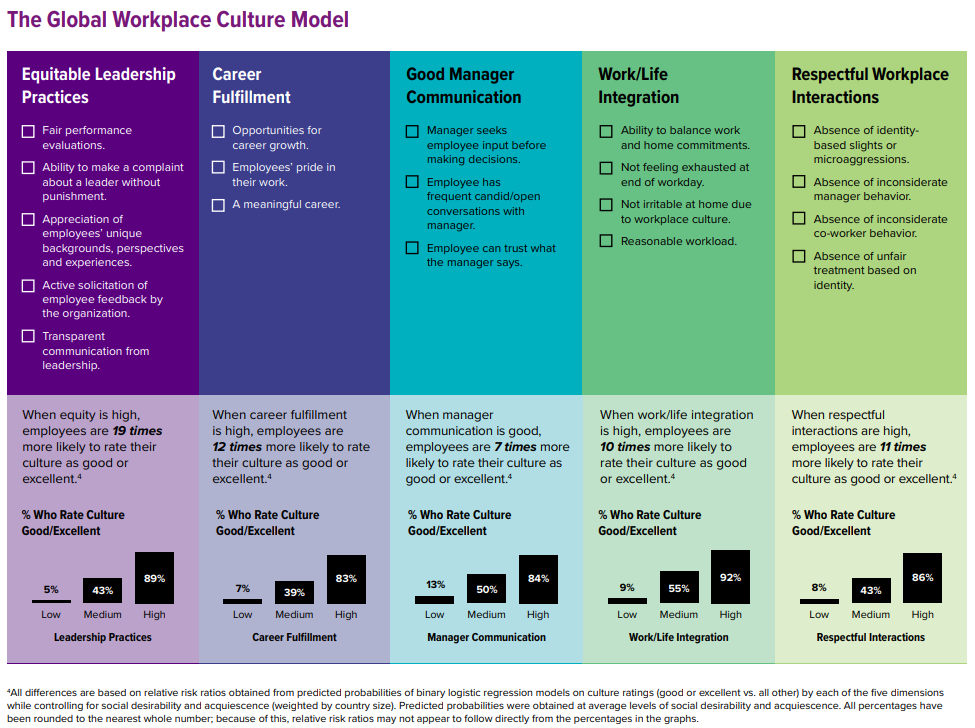By Victor Assad, Managing Partner of InnovationOne, LLC
Employees who work in organizations with a positive culture are overwhelmingly more satisfied at work and are consistently more committed to their organizations.
That was the conclusion of a recent workplace culture study by the Society of Human Resources (SHRM) of 15 countries. And SHRM’s work is only one of a parade of studies showing the importance of workplace culture for having more satisfied employees, reducing turnover, and driving improved stockholder value, innovation, productivity, and financial outcomes.
SHRM learned from their study that a positive culture increases commitment and job satisfaction and lowers intent to quit globally. For example:
- 790 percent were more likely to feel satisfied at work.
- 96 percent were less likely to dread going to work.
- 83 percent were less likely to be actively looking for a job.
- 78 percent were less likely to have actively looked for a new job in the last six months.
SHRM’s global workplace culture model has five dimensions
Part of SHRM’s study was to determine which employee practices were consistently associated with a positive culture. To answer these questions, SHRM presented its respondents with more than 50 employer practices. Then, SHRM examined which practices were consistently associated with positive workplace culture perceptions and how those practices could be grouped to create actionable areas for employers.
SHRM found that five key dimensions influence employees’ workplace culture perceptions regardless of the country where they work. They were:
- Equitable leadership practices
- Career fulfillment
- Good manager communication
- Work/life integration
- Respectful workplace interactions
SHRM defines each practice in the chart below of the SHRM Global Workplace Culture Model
Which dimension is rated the best and worst by employees globally?
SHRM has found that few employees globally gave their organizations low ratings on the five dimensions. Career fulfillment is a bright spot with at least half of respondents reported being highly fulfilled by their work. By contrast, maintaining respectful interactions in the workplace is a common challenge. In the US, the highest-scoring country on this dimension, fewer than six in ten employees perceive highly respectful workplace interactions, and nine of the remaining countries cluster around the 50 percent mark.
As well, work/life integration shows only 32 percent of employees experiencing high work/life integration, while 55 percent report moderate work/life integration.
Please see the SHRM chart below on how employers fare on the five dimensions of SHRM’s Global Workplace Culture Model.
Why employees decide to stay or leave an employer
SHRM has found that while most employees often cited job security as a reason for staying with their employers, the second reason is workforce flexibility, the third is fair treatment, and then fourth is good management. All of these are aspects of a positive organizational culture. Significantly, each of these is ranked above competitive pay (the fifth reason) as a reason to stay.
Please see SHRM’s chart below on the Top Five Reasons Why Employees Worldwide Plan to Stay with their Employer.
Conversely, when employees decide to leave their employer, inadequate pay is the top reason to leave, followed by insufficient career growth opportunities, poor management, insufficient learning and professional development opportunities, and unfair treatment.
Please see SHRM’s chart below on the Top Five Reasons Why Employees Worldwide Plan to Leave their Employer.
Other researchers have found that culture drives employee turnover—significantly more than pay
Last year, MIT researchers uncovered that toxic organizational cultures drive employee turnover ten times more than pay.
The MIT researchers examined 34 million online employee profiles on Glassdoor to identify US workers who left their employer for any reason (including quitting, retiring, or being laid off) between April and September 2021, which was at the height of the pandemic. They found that attrition rates ranged from less than two percent to more than 30 percent across companies for the six months they studied. The industry was responsible for some of this variation, with retail, management consulting, internet, software, fast food, leisure, and healthcare industries leading the way. Learn more
MIT’s result is consistent with a large body of evidence that pay has only a moderate impact on employee turnover.[i]
Other research has found that strong organizational cultures significantly improve performance
John P. Kotter and James L. Heskett in their book Corporate Culture and Performance, 1992, reported that firms with innovative and adaptive cultures achieve extraordinary financial results, including nearly three times the review growth, 900 percent higher stock price growth and 755 percent higher net income growth.
At InnovationOne, our empirical research on organizational cultures geared to improving learning, collaboration, and innovation revealed that companies scoring in the top quartile of our InnovationOne Culture Index© reported higher financial performance than those in the bottom quartile of our index by as much as 22 percent. (Note, I am a managing partner of InnovationOne.)
Organizations that want to improve their performance in our turbulent times should focus on improving their organizational culture. A parade of studies has clearly shown that improved corporate culture will lead to happier employees and improved business performance.
About InnovationOne®, LLC.
InnovationOne®, LLC helps organizations worldwide build a culture of innovation and make it sustainable. InnovationOne® uses a scientifically developed assessment to measure, benchmark, and improve your company’s culture and capability to innovate and enjoy better outcomes and financial results. Companies scoring in the top quartile of our InnovationOne Culture Index© reported higher financial performance than bottom quartile performers by as much as 22 percent. Measure and ignite your culture of innovation.
[i] A.L. Rubenstein, M.B. Eberly, T.W. Lee, et al., “Surveying the Forest: A Meta-Analysis, Moderator Investigation, and Future-Oriented Discussion of the Antecedents of Voluntary Employee Turnover,” Personnel Psychology 71, no. 1 (spring 2018): 23-65; and D.G. Allen, P.C. Bryant, and J.M. Vardaman, “Retaining Talent: Replacing Misconceptions With Evidence-Based Strategies,” Academy of Management Perspectives 24, no. 2 (May 2010): 48-64.





